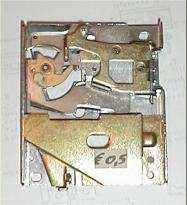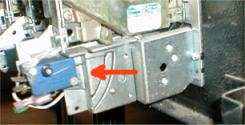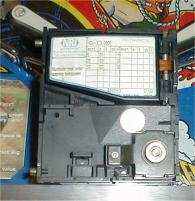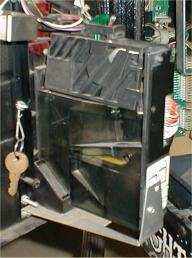Coin validators in pinball machines
Pinball games are commercial machines, they have to earn money, and therefor accept money. That's why they have coin mechanisms. On all pinball games these are located on the inside of the coin door. You drop a coin in the slot, it goes through the coin mech and is validated. If it's a valid coin which the machine can accept, it'll fall into the cash box and credits are added, if not your coin is returned.
There are basically 2 types of coin mechs: mechanical and electronic.
Mechanical coin validator
As the name says, these are pure mechanical devices. Coins fall through the mechanism which evaluates their weight, size and magnetic property. If it passes the tests, the coin triggers a microswitch whilst falling into the cash box and a credit is added. If it fails the tests, the coin is diverted and returned. The switch which is activated when the coin is good, is not part of the coin validator but on the door frame itself. So even if this coin mech is removed, it's still possible to add coins by hand. (red arrow in picture)


These mechs are still popular in the USA today, as almost all games accept quarters. These coin mechs are cheap, and most games have 2 or 3 of them (in case one fails or is jammed there is still another one available). However, they can only accept one type of coin and cannot be changed to a different size (unless you 'hack' them like Leon describes on his website). Another disadvantage is they can jam.
Electronic coin mechs
These devices can be programmed to identify multiple coins (usually up to 10 types of coins).
Most games in Europe have them installed. In the past most countries had
several coins as currency which could be used to pay for a game.
With the introduction of the euro coins this has remained,
as most pinball games now accept 50 cent, 1 euro and 2 euro coins.
So in Europe games usually only have 1 coin slot with an electronic coin
validator installed.
This type has the advantage of accepting multiple types of coins,
don't jam as much, and can be reprogrammed for other types of coins.
Unfortunately they are more expensive. This is also a reason why in Europe
a lot of operators remove them when they sell a machine.
Remark: never disconnect an electronic coin mech while the game is switched on !
The most types of coin validators user in Bally/Williams pinball machines are NRI and Coin Controls models C120 and C220.


Two types of coin mechs exist: short and high. The mechanical coin mechs in pinball machines are always the small types. Only juke boxes almost always have high types. I noticed electronic coin mechs on Bally/Williams games are usually the high type, while Data East games use the small type.. Some 90ies Williams/Bally games also have both types, a few small mechanical and one electronic coin mech. These settings may depend on the country the game was produced for. I don't have exact sizes, but as you can see in the pictures, the short model is almost square and about half the size of a coin door, while the high model is almost the full height of a coin door.
There is a connector going to the coin mech. There isn't a separate switch which a coin activates. So if you have a game using electronic coin mechs, you cannot put mechanic coin mechs in ! And if the electronic coin mech is missing, it is impossible to 'fake' the machine thinking a coin has been inserted by manually triggering a switch, the only way to play the machine now is to put service credits on it (check your game manual) or put it to free play.
Bill validators
Some games also have a bill validator installed. Installation and operation can be compared to electronic coin mechs. Recent Bally/Williams games (from around 1996-97) have coin doors to which a bill validator can be added. These were never installed by default from the factory, and as far as I know they're mainly used in the USA on pinball machines.
Set a pinball machine on free play
A game set to free play means you do not have to insert coins to start a game. Play as much games as you want. For free. On modern solid state games this is done by an adjustment in the software. Older solid state games don't have this option. You have to cheat, by adding a switch so the game thinks a coin has been inserted, or set the replay value very low so every game you play earns you a new free game..
Electro-mechanical pinball machines have a credit wheel behind the backglass. There are different ways to change these to free play. You can add a switch which fools the machine in thinking a coin has been added. You can also disconnect a coil on the credit wheels so no credits get removed, ...
Most games play a special sound when you insert a coin. Therefor a lot of people prefer to keep their game at home on pay-for-play. Playing for money also motivates you to play well, and earning a free game still means something. The money in the machine can be spent on parts or go towards a new machine..
On WPC games you can set free play in adjustment A.3-17. So:
- Adjustments
- 3. Pricing adjustments
- 17. Free Play.
On Data East games you first have to select 'expand adjustments' (set to YES by pressing the start button when this option shows) and then you can continue until you see 'Free play'.
